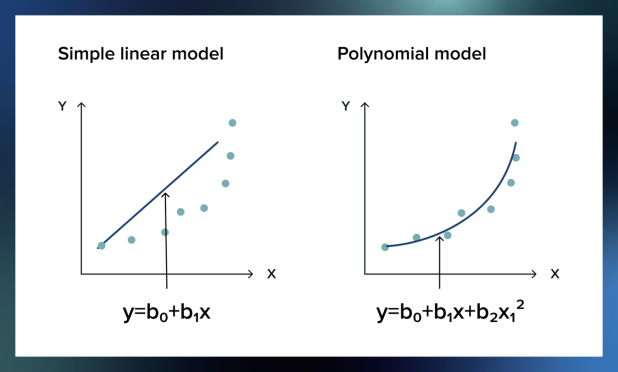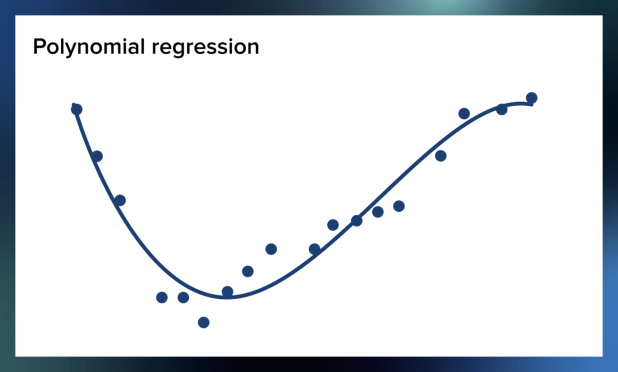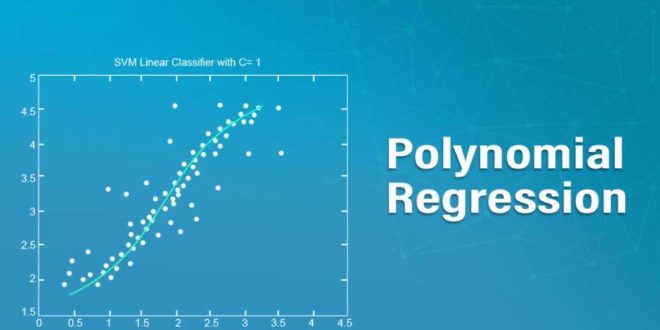In this guide, we will be discussing what polynomial regression is in machine learning. We will also be exploring how it works and why it’s superior to linear regression. Finally, we will provide a few examples to help illustrate how polynomial regression can be used in practice. Let’s begin.
Table of Contents
What Is Polynomial Regression In Machine Learning?
Polynomial regression is a type of regression analysis where the relationship between the independent variable(s) and the dependent variable(s) is modelled as a polynomial. Polynomial regression can be used to model linear relationships as well as non-linear relationships.
How Does It Work?
The basic idea behind polynomial regression is to find the best fit curve for a given set of data points. This is done by first fitting a line to the data and then finding the equation of that line. The coefficients of that equation are then used to fit a second line, and so on until a good fit is found.
Why Do We Need It?
We need it because linear regression is only capable of modelling linear relationships. On the other hand, polynomial regression can be used to model linear relationships as well as non-linear relationships. Therefore, if the relationship between the independent and dependent variables is non-linear, we need to use polynomial regression.
Linear Regression Vs Polynomial Regression

Linear regression is a statistical technique used to obtain a linear relationship between a dependent variable and one or more independent variables. The general form of linear regression is:
Y = b0 + b1X1 + b2X2 + … + bnXn
…where Y is the dependent variable, X1, X2 … Xn are the independent variables, and b0, b1, b2 … bn are the estimated regression coefficients.
Polynomial regression is a statistical technique used to obtain a nonlinear relationship between a dependent variable and one or more independent variables. The general form of polynomial regression is:
Y = b0 + b1X1 + b2X12 + b2X13 + … bnXnn
…where Y is the dependent variable, X1, X2 … Xn are the independent variables, and b0, b1, b2 … bn are the parameters you can optimize.
The main difference between linear and polynomial regression is that linear regression model a linear relationship between the dependent variable and the independent variables while polynomial regression models a nonlinear relationship between the dependent variable and the independent variables.
Polynomial regression can be used to model relationships between the dependent variable and one or more independent variables when linear regression cannot be used because the relationship is not linear.
Now, we know this isn’t easy to grasp, so if you want to get a simple and clear explanation of the complicated regression analysis, check this post, it’s my favourite!
Advantages Of Using Polynomial Regression In Machine Learning

Let’s observe some of the advantages polynomial regression will offer to your next machine learning model:
- Polynomial regression can be used to model relationships between the dependent variable and one or more independent variables when linear regression cannot be used because the relationship is not linear.
- There is a large range of different functions that you can use for fitting. You can use them to fit your data to a line, or you can use them to generate predictions. You can also use them to assess the goodness of fit of your data to a line.
- It’s good for exploration purposes when you want to test for the presence of the curvature and its inflexions. This could be helpful when you want to know about the potential future values of your dependent variable.
Disadvantages Of Using Polynomial Regression In Machine Learning
Now, let’s delve into the bad sides of this model.
- It’s easy to get the wrong results. Even if there’s a single outlier in the data, the results can be seriously misleading and blatantly wrong.
- It’s prone to overfitting. When you have too many polynomial terms or parameters, anything goes. The model will try to fit the noise in the data rather than the actual signal. It won’t not easy to interpret the results.
- The models might not generalize well to unseen data. When your test data is different from the training data, the results can be completely different from what you expect.
When To Use Polynomial Regression In Machine Learning?

Polynomial regression can be used in a wide range of machine learning applications, including the following practical examples:
Death Rate Prediction
With polynomial regression, we can model the relationships between death rates and the factors that influence them. In this way, we can not only predict the death rate in future pandemics but also identify which factors are most important in determining the severity of a disease.
Stock Market Fluctuations
Polynomial regression can be used to model the relationships between stock prices and the factors that influence them. In doing so, we can not only anticipate future stock prices, but we can also determine which factors are most essential in influencing the fluctuations of the stock of a certain company.
Tissue Growth Rate Prediction
Polynomial regression can be used to model the relationships between tissue growth rates and the factors that influence them. This would not only allow us to monitor tumour growth and spread but also focus on the positives, like the development of a new life inside the womb for the earliest stages.
Housing Market Price Predictions

Another practical application where polynomial regression could be used is to predict housing prices. By taking into account the different features of a house like size, location, age, etc., we can generate more accurate predictions than linear models, leading to better investments.
Social Media Growth Patterns And Predictions
Social media is one of the most disruptive technologies of our time. With polynomial regression, we can model the relationships between social media growth and the factors that influence it. By implementing it, we can not only predict future user growth for different platforms but also identify which factors are most important in determining the popularity of a social media platform, which could help us better understand how to grow and scale social media businesses.
Conclusion – How Important Will Polynomial Regression Become In The Future?
The current state of machine learning is still in its infancy. We are only just beginning to scratch the surface of its potential applications. As we continue to develop more sophisticated algorithms and models, the possibilities are endless.
So, how important will polynomial regression become in the future? Only time will tell. But one thing is for sure: it will continue to play a vital role in a wide range of machine learning applications, from stock market predictions to combating cancer.
So, if you’re looking to get ahead of the curve, it’s definitely worth keeping an eye on this powerful instrument.
 World Magazine 2024
World Magazine 2024





